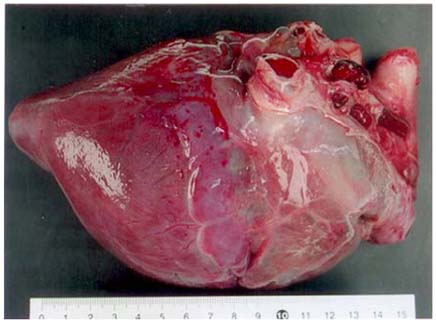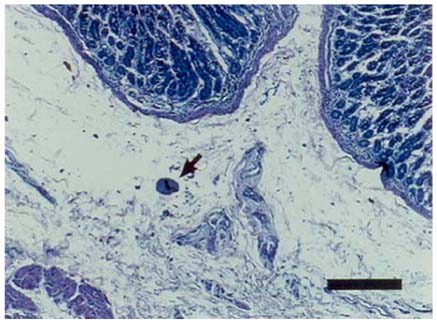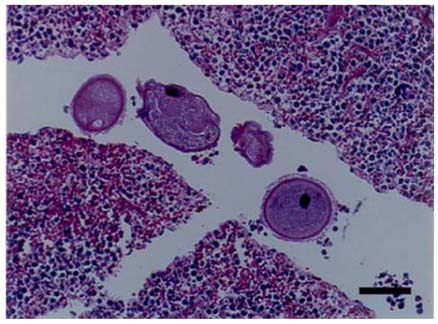J Vet Sci.
2006 Jun;7(2):207-209. 10.4142/jvs.2006.7.2.207.
Balantidiasis in the gastric lymph nodes of Barbary sheep (Ammotragus lervia): an incidental finding
- Affiliations
-
- 1Department of Veterinary Pathology, College of Veterinary Medicine, Chonnam National University, Gwangju 500-757, Korea. nypark@chonnam.ac.kr
- 2Department of Veterinary Parasitology, College of Veterinary Medicine, Chonnam National University, Gwangju 500-757, Korea.
- KMID: 1059211
- DOI: http://doi.org/10.4142/jvs.2006.7.2.207
Abstract
- A 4-year-old female Barbary sheep (Ammotragus lervia) was found dead in the Gwangju Uchi Park Zoo. The animal had previously exhibited weakness and lethargy, but no signs of diarrhea. The carcass was emaciated upon presentation. The main gross lesion was characterized by severe serous atrophy of the fat tissues of the coronary and left ventricular grooves, resulting in the transformation of the fat to a gelatinous material. The rumen was fully distended with food, while the abomasum evidenced mucosal corrugation with slight congestion. Microscopic examination revealed the presence of Balantidium coli trophozoites within the lymphatic ducts of the gastric lymph node and the abdominal submucosa. On rare occasions, these organisms may invade extra-intestinal organs, in this case the gastric lymph nodes and abomasum.
MeSH Terms
Figure
Reference
-
1. Anargyrou K, Petrikkos GL, Suller MT, Skiada A, Siakantaris MP, Osuntoyinbo RT, Pangalis G, Vaiopoulos G. Pulmonary Balantidium coli infection in a leukemic patient. Am J Hematol. 2003. 73:180–183.2. Arean VM, Koppisch E. Balantidiasis: a review and report of cases. Am J Pathol. 1956. 32:1089–1115.3. Baskerville L, Ahmed Y, Ramchad S. Balantidium colitis. Am J Dig Dis. 1970. 15:727–731.4. Jones TC, Hunt RD, King NW. Veterinary Pathology. 1997. 6th ed. Baltimore: Williams & Wilkins;583.5. Jubb KVF, Kennedy PC, Palmer N. Pathology of Domestic Animals. 1997. Vol. 2:6th ed. New York: Academic Press;317–318.6. Karere GM, Munene E. Some gastro-intestinal tract parasites in wild De Brazza's monkeys (Cercopithecus neglectus) in Kenya. Vet Parasitol. 2002. 110:153–157.
Article7. Knight R. Giardiasis, isosporiasis and balantidiasis. Clin Gastroenterol. 1978. 7:31–47.8. Levine ND. Veterinary Protozoology. 1985. Ames: Iowa State University Press;361–362.9. Permin A, Yelifari L, Bloch P, Steenhard N, Hansen NP, Nansen P. Parasites in cross-bred pigs in the upper East Region of Ghana. Vet Parasitol. 1999. 87:63–71.
Article10. Rubin E, Farber JL. Pathology. 1999. 3rd ed. Baltimore: Williams & Wilkins;455.11. Sharma S, Harding G. Necrotizing lung infection caused by the protozoan Balantidium coli. Can J Infect Dis. 2003. 14:163–166.12. Solaymani-Mohammadi S, Rezaian M, Hooshyar H, Mowlavi GR, Babaei Z, Anwar MA. Intestinal protozoa in wild boars (Sus scrofa) in Western Iran. J Wildl Dis. 2004. 40:801–803.13. Vasilakopoulou A, Dimarongona K, Samakovli A, Papadimitris K, Avlami A. Balantidium coli pneumonia in an immunocompromised patient. Scand J Infect Dis. 2003. 35:144–146.14. Wegner F. Abscesso hepatico producido por el Balantidium coli. Casemera. 1967. 2:433–441.
- Full Text Links
- Actions
-
Cited
- CITED
-
- Close
- Share
- Similar articles
-
- Nevus Cell Inclusions in the Lymph Node: A Report of Two Cases
- Minimum Number of Retrieved Lymph Nodes for Staging in Gastric Cancer
- The Significance of Immunohistochemical Study in the Evaluation of Lymph Node Metastasis from Gastric Adenocarcinoma
- Stage Migration of Gastric Cancer According to the Extent of Lymph Node Dissection
- Proposal of the Nodal Stage Based on the Number of Metastatic Lymph Nodes in Patients with Gastric Cancer




